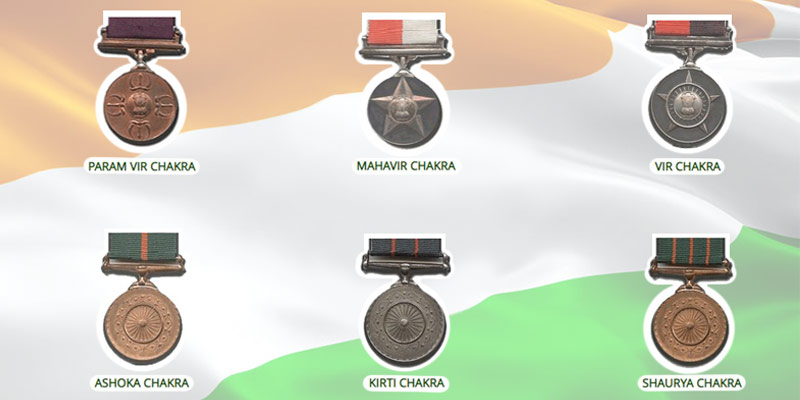- India
- Jan 27
President Murmu approves 93 gallantry awards
• On the eve of the 76th Republic Day, President Droupadi Murmu approved gallantry awards to 93 Armed Forces personnel.
• These include two Kirti Chakras, including one posthumous; 14 Shaurya Chakras, including three posthumous; one Bar to Sena Medal; 66 Sena Medals, including seven posthumous; two Nao Sena Medal and eight Vayu Sena Medals, including one posthumous.
• The President also approved 305 defence decorations to the Armed Forces and other personnel.
• These include 30 Param Vishisht Seva Medals; five Uttam Yudh Seva Medals; 57 Ati Vishisht Seva Medals; 10 Yudh Seva Medals; one Bar to Sena Medals; 43 Sena Medals; eight Nao Sena Medals; 15 Vayu Sena Medals; four Bar to Vishisht Seva Medal and 132 Vishisht Seva Medals.
• Naik Dilwar Khan, who was killed in action in an anti-terror operation in Lolab Valley of Kupwara in Jammu & Kashmir in July 2024 has been posthumously awarded the Kirti Chakra.
• Major Manjit, who displayed outstanding leadership in a separate operation against two “foreign” terrorists in Sopore in April 2024, was also awarded the Kirti Chakra.
• Naik Khan was from the artillery (28 Rashtriya Rifles). Major Manjit is from the Punjab regiment (22 Rashtriya Rifles).
Gallantry awards in India
• Post-Independence, first three gallantry awards namely Param Vir Chakra, Maha Vir Chakra and Vir Chakra were instituted by the government of India on January 26, 1950 which were deemed to have effect from August 15, 1947.
• Thereafter, other three gallantry awards — the Ashoka Chakra Class-I, the Ashoka Chakra Class-II and the Ashoka Chakra Class-III — were instituted on January 4, 1952, which were deemed to have effect from August 15, 1947. These awards were renamed as Ashoka Chakra, Kirti Chakra and Shaurya Chakra respectively in January 1967.
• These gallantry awards are announced twice in a year — first on the occasion of the Republic Day and then on the occasion of the Independence Day.
• Param Vir Chakra: It is India’s highest military decoration awarded for displaying distinguished acts of valour during wartime whether on land, at sea or in the air.
• Maha Vir Chakra: It is the second highest gallantry award for acts of conspicuous gallantry in the presence of the enemy whether on land, at sea or in the air.
• Vir Chakra: It is India’s third-highest war time gallantry medal awarded for acts of bravery in the presence of the enemy, whether on land or at sea or in the air.
• Ashoka Chakra: It is the highest military award during peacetime for valour, courageous action or sacrifice.
• Kirti Chakra: It is awarded for conspicuous gallantry otherwise than in the face of the enemy. It is the peacetime equivalent of the Maha Vir Chakra. It is second in order of precedence of peacetime gallantry awards.
• Shaurya Chakra: It is awarded for gallantry otherwise than in the face of the enemy. It is third in order of precedence of peacetime gallantry awards.
• Sena Medal: It is awarded for acts of exceptional devotion to duty or courage in the Army.
• Nao Sena Medal: It is awarded for individual acts of exceptional devotion to duty or courage in the Navy.
• Vayu Sena Medal: It is awarded for individual acts of exceptional devotion to duty or courage in the Air Force.
• Mention in Despatches: It was instituted in 1950 for distinguished and meritorious service in operational areas and acts of gallantry which are not of a sufficiently high order to warrant the grant of gallantry awards. Names may be included posthumously.
• Bar: If a recipient of the medal is subsequently awarded the medal again, every such further award shall be recognised by a Bar to be attached to the riband.
Distinguished Awards
• Sarvottam Yudh Seva Medal: It was instituted in 1980 to recognise the distinguished service of the most exceptional order during war/conflict/hostilities. The medal may be awarded posthumously.
• Param Vishisht Seva Medal: It was instituted in 1960 to recognise distinguished service of the most exceptional order. The medal may be awarded posthumously.
• Uttam Yudh Seva Medal: It was instituted in 1980 for distinguished service of an exceptional order during war, conflict or hostilities. The medal may be awarded posthumously.
• Ati Vishisht Seva Medal: Vishisht Seva Medal Class II, which was instituted in 1960, was redesignated as Ati Vishisht Seva Medal in 1967. It is awarded for distinguished service of an exceptional order. The medal may be awarded posthumously.
• Yudh Seva Medal: It was instituted in 1980 for distinguished service of a high order during war/conflict/hostilities. The medal may be awarded posthumously.
• Vishisht Seva Medal: It was instituted in 1960 and as VSM Class-III to recognise the distinguished service of a high order. It was renamed in 1967 as Vishisht Seva Medal.
Manorama Yearbook app is now available on Google Play Store and iOS App Store


